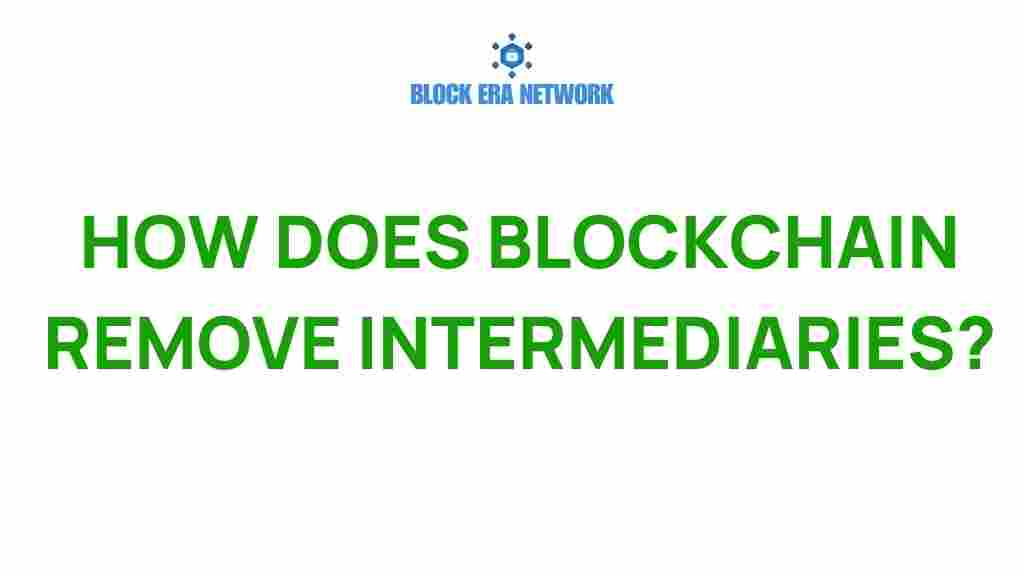How Blockchain Revolutionizes Transactions by Eliminating Intermediaries
The world of financial services is undergoing a significant transformation, and at the heart of this revolution is blockchain technology. This innovation is reshaping how transactions are conducted, offering enhanced efficiency, transparency, and security. In this article, we will explore how blockchain eliminates intermediaries, streamlining transactions and creating a decentralized environment that benefits individuals and businesses alike.
What is Blockchain?
Blockchain is a distributed ledger technology that enables the secure recording of transactions across multiple computers. By decentralizing data, it eliminates the need for a central authority, thereby reducing costs and increasing transparency in the process. Each block in the chain contains a list of transactions, and once a block is filled, it is linked to the previous block, creating a secure and unchangeable history of all transactions.
The Role of Intermediaries in Transactions
Traditionally, intermediaries—such as banks, brokers, and payment processors—have played a crucial role in facilitating transactions. They help verify and process payments, ensure compliance with regulations, and provide a layer of security. However, this reliance on intermediaries often leads to:
- Increased Costs: Fees and commissions add up, making transactions expensive.
- Slower Transactions: Processing times can be lengthy, especially for cross-border payments.
- Less Transparency: Users may not have full visibility into transaction processes.
How Blockchain Eliminates Intermediaries
Blockchain technology offers a solution to these challenges by enabling direct peer-to-peer transactions. Here’s how it achieves this:
1. Decentralization
With blockchain, there is no need for a central authority to oversee transactions. This decentralization means that users can interact directly with one another, reducing the reliance on intermediaries.
2. Smart Contracts
Smart contracts are self-executing contracts with the terms of the agreement directly written into code. They automate processes, ensuring that transactions are executed only when predetermined conditions are met, further eliminating the need for third-party intervention.
3. Enhanced Security
Blockchain employs advanced cryptography to secure data. Each transaction is encrypted and linked to the previous one, making it nearly impossible for unauthorized parties to alter transaction records. This level of security enhances transparency and trust among users.
Benefits of Blockchain in Transactions
By eliminating intermediaries, blockchain technology offers several benefits for transactions, particularly in the financial services sector:
- Cost Efficiency: Reduced fees and commissions lead to lower costs for consumers and businesses.
- Speed: Transactions can be processed in real-time, significantly speeding up the transfer of funds.
- Transparency: All transaction records are visible to all parties involved, making it easier to track and verify transactions.
- Accessibility: Blockchain opens up financial services to unbanked populations, allowing anyone with internet access to participate in the economy.
Step-by-Step Process of Blockchain Transactions
Understanding how blockchain transactions work is essential to appreciate their efficiency. Here’s a simplified step-by-step process:
Step 1: Transaction Initiation
A user initiates a transaction by creating a request, which includes details like the amount and recipient’s address.
Step 2: Transaction Validation
The transaction is broadcasted to the network, where it is validated by multiple nodes (computers) in the blockchain network. Each node checks the validity of the transaction against the existing records.
Step 3: Block Creation
Once validated, the transaction is grouped with others to form a new block. This block contains a unique cryptographic hash of the previous block, linking them securely.
Step 4: Consensus Mechanism
The nodes in the network use a consensus mechanism (like Proof of Work or Proof of Stake) to agree on the validity of the new block. This step ensures that all copies of the blockchain are the same across the network.
Step 5: Block Addition
Once consensus is achieved, the new block is added to the blockchain, and the transaction is considered complete. The updated blockchain is then distributed across the network, ensuring that all nodes have the latest version.
Step 6: Confirmation
The recipient can now see the transaction in their blockchain wallet, and the funds are available for use. This entire process can happen in minutes, compared to traditional methods that may take days.
Troubleshooting Blockchain Transactions
While blockchain transactions are generally reliable, users may encounter issues. Here are some common problems and how to address them:
- Transaction Not Confirmed: If a transaction is pending for too long, check the network congestion and consider increasing the transaction fee to expedite processing.
- Incorrect Recipient Address: Always double-check the recipient’s address before sending funds, as transactions are irreversible.
- Wallet Access Issues: Ensure you have backed up your wallet’s private keys. If you lose access, you may lose your funds permanently.
The Future of Blockchain in Financial Services
The adoption of blockchain technology in financial services is still in its early stages, but the potential for innovation is vast. Financial institutions are beginning to explore ways to integrate blockchain into their operations, leading to:
- Improved Cross-Border Transactions: Blockchain can streamline and reduce costs for international money transfers.
- Tokenization of Assets: Real-world assets can be represented as tokens on the blockchain, increasing liquidity and access to investment opportunities.
- Decentralized Finance (DeFi): DeFi platforms are emerging, allowing users to lend, borrow, and earn interest on cryptocurrencies without traditional banking systems.
As these innovations develop, the role of intermediaries may continue to diminish, further enhancing the efficiency and transparency of financial transactions.
Conclusion
In conclusion, blockchain technology is revolutionizing transactions by eliminating intermediaries and fostering a decentralized approach. The benefits of this technology, including increased efficiency, lower costs, and enhanced transparency, position it as a powerful tool in the financial services industry and beyond. As we move forward, embracing this innovation will be crucial for businesses and individuals looking to thrive in an increasingly digital economy.
For further reading about the role of blockchain in financial innovation, check out this Investopedia article. If you are interested in exploring blockchain solutions, visit our services page for more information.
This article is in the category Blockchain Basics and created by Block Era Network Team

1 thought on “How Blockchain Revolutionizes Transactions by Eliminating Intermediaries”